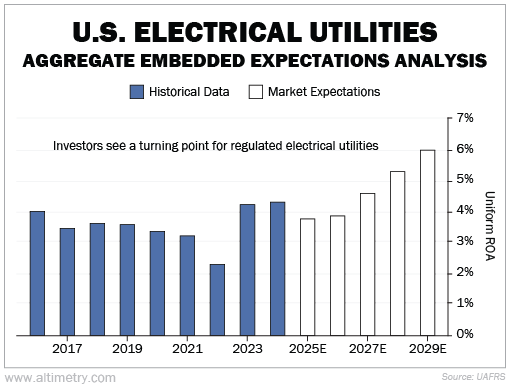An Unexpected Winner of the Boom in Energy Demand
Editor's note: AI is here to stay... which means the burden on our electrical grid will only grow. According to Joel Litman of our corporate affiliate Altimetry, that spells opportunity for the energy industry. In this essay – which originally appeared in the free Altimetry Daily Authority newsletter on August 12 – Joel explains why money is about to flow into the space... and names an unexpected beneficiary of the AI energy boom.
This summer, residents across Columbus, Ohio opened their energy bills to find an unpleasant surprise...
Their monthly bills had jumped an unexpected $27.
And the culprit wasn't a heat wave or a new power plant tax...
It was artificial intelligence ("AI").
The surge came as utility companies scrambled to supply power to nearby data centers. These aren't your average server rooms... They're sprawling, high-intensity AI clusters.
Each one demands as much electricity as tens of thousands of homes.
This trend isn't isolated to Ohio. Capacity prices at PJM Interconnection, which oversees energy flow in 13 states, shot up more than 830% last year. Nearly three-quarters of that jump was tied directly to data-center demand.
From Virginia to Illinois, the pattern is repeating. Utilities are paying a premium to keep the grid on line. They're passing the cost straight to consumers.
But that doesn't mean there's no way to profit. Thanks to some key regulatory changes, the tide may be turning for a once-sleepy energy mainstay...
What's Next for Regulated Utilities
Independent power producers are the first to profit from the AI energy boom...
Also called "IPPs," these companies are a bit different from your usual energy utility.
Utilities own and operate most power plants. And since most utilities have a monopoly over their regions, they're heavily regulated. They can only charge a slight premium above their costs, at prenegotiated rates.
Regulation stabilizes utilities' returns when energy prices are low. But it also caps profitability when prices rise.
IPPs sell power to customers at the market rate. And while they struggle when energy prices are low, they outperform traditional utilities when prices take off.
In today's AI-heavy environment, IPPs are in a prime position. Vistra (VST), one of the biggest IPPs in the U.S., is seeing cash flows surge alongside energy prices.
The market has been quick to react. Shares are up nearly 150% in the past year.
IPPs have become indispensable in deregulated markets like Texas and parts of the Midwest. They're helping meet the grid's growing needs while generating higher margins than their traditional utility peers.
Regulated utilities, meanwhile, have lagged in profitability. Because their rates are set by state commissions, they can't always raise prices to reflect higher costs.
But pretty soon, regulated utilities might follow in IPPs' footsteps...
In the first half of 2025, utilities requested a record $29 billion in rate adjustments.
Typically, about 60% of any particular rate increase gets approved. So we're in for a record year of utility prices... and utility profits.
The market is taking notice. We can see this through our aggregate Embedded Expectations Analysis ("EEA") framework...
This framework tells us how well the U.S. regulated electrical utility industry has to perform in the future to be worth what the market is paying for it today.
To see this, we start with the average stock price of all U.S. regulated electrical utility companies. From there, we can calculate what the market expects from future cash flows. Finally, we compare that with our own cash-flow projections.
Profitability has been stable enough in this industry... but nothing to write home about. Uniform return on assets ("ROA"), a measure of this industry's profitability, has hovered around breakeven, between 3% and 4% over the past decade.
But even regulated utilities are finding ways to recoup their investments faster. Investors are getting excited. They think Uniform returns can reach 6% by 2029. Take a look...
Investors believe regulated utilities will follow in the footsteps of IPPs. If that happens, industry valuations won't stay put for long.
This could be one of the biggest regulatory changes we've seen in energy...
Investors already expect higher returns out of regulated utilities. Regulators are helping these companies funnel cash into important investments, like transmission upgrades and battery storage.
In short, utilities should start to make a bit more money than they have in the past.
This has long been viewed as a sleepy industry because of profit caps. But investors know the story is changing for utility stocks. Expect a lot more eyes on the energy and power industries.
Good investing,
Joel Litman
Editor's note: President Donald Trump is about to make a radical new move that could send one U.S. sector to historic new highs – while likely killing off several others. Warren Buffett himself is calling this "the greatest transfer of wealth in human history"... yet most investors have no idea what's going on. The last time this happened, you could have seen multiple chances to grow your money by 5 times or more – but you need to act by September 30.
Further Reading
"At midnight on September 30, the U.S. energy market will be transformed," Joel writes. That's because of a sweeping deregulation initiative set to ignite the next great AI rally. It promises to send ripples across the energy industry... and spark a boom in natural gas.
"No one-size-fits-all allocation is right for every investor," Porter Stansberry says. Don't make the mistake of blindly following generic advice for diversifying your investments. Instead, by following four key principles, you can set yourself up to dramatically outperform those who just follow the status quo.


